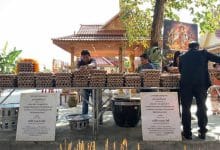Thao Wessuwan spirit invocation ceremony in Rayong draws devout Buddhists and tourists

Amidst a downpour, villagers assembled for a traditional ‘Thao Wessuwan’ spirit invocation ceremony at the Wat Noen Suk temple, also known as Wat Laok, in Rayong province yesterday. The event, led by Anan Nakniyom, the Deputy Governor of Rayong, saw participation from various government and private sector organisations, as well as devout local Buddhists.
The temple area turned into a religious and cultural feast with the burning of 99,999 sticks of incense, the erection of a charity tent by spirited villagers, and a nostalgic performance of traditional dance and film. The lucky numbers for the government lottery, which is due tomorrow, were revealed to be 79 (the registration number of the shuttle vehicle), and the tail numbers 829 and 65.
Wat Noen Suk is also home to a 1-metre tall statue of Luang Phor La-Ok, and 4-metre tall twin statues of the deity Thao Wessuwan. The revered statues, erected at the front of the temple, were initiated by Maha Chakkrit Thammaphatto, the temple’s abbot, and were sponsored at the cost of nearly 400,000 baht.
Meanwhile, Annop Tanwimol, the headman of Thung Khwai Kin village, highlighted the purpose of the event. According to him, it was designed to enable villagers who revere Thao Wessuwan to come and worship for the prosperity and security of their families, reported Sanook.
Ancient beliefs say Thao Wessuwan is the ruler of demons or the lord of the spirits and goblins. Those who worship him are believed to be granted wealth. He is also said to help overcome disasters, protect against spirits and evil entities, and secure safety. The Wat Noen Suk community expressed their gratitude for the good fortune that everyone received in the process.
Additionally, the area is forging its image as a new landmark for tourists on their way to the Khao Chamao-Khao Wong National Park. The temple area, adjacent to the forested hill, offers panoramic views from the top where Luang Pho Noen Suk is also situated. Below the temple, there’s a dedicated shrine to the goddess of mercy.
Latest Thailand News
Follow The Thaiger on Google News:


























